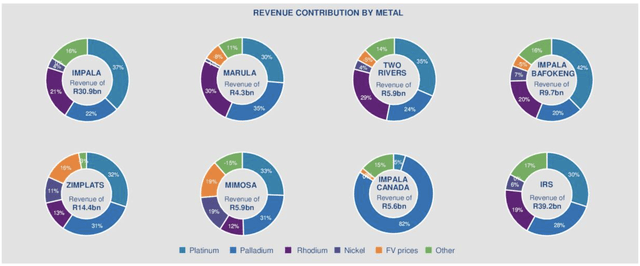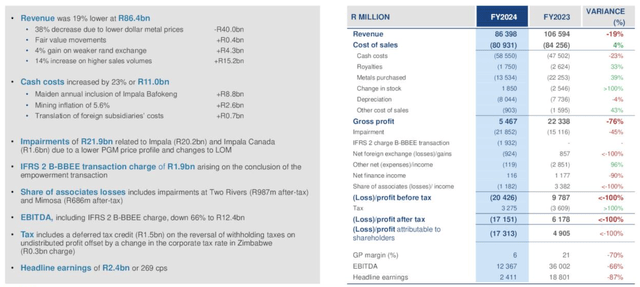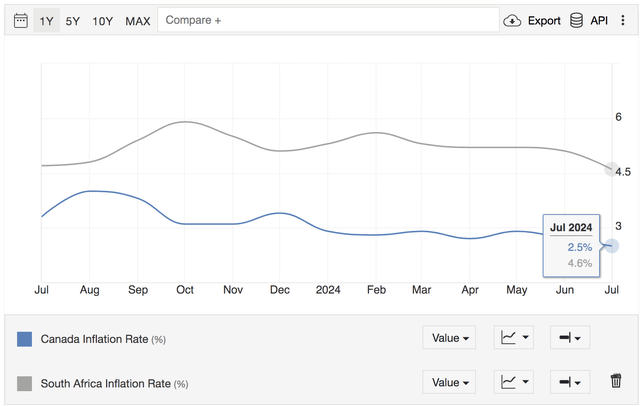Stefan Kuerzinger/iStock via Getty Images
Impala Platinum Holdings Limited (OTCQX:IMPUY) released its full-year results last week, revealing a dramatic downturn in its top and bottom line figures. Although the company’s latest fiscal results were somewhat expected, Impala faces trying times, meaning investors might soon reassess their long-term commitment to its stock.
We last covered Impala Platinum’s stock in June 2023, arguing that the company had telling hidden assets. However, despite our fundamental optimism, we deemed Impala Platinum’s stock a hold.
Considering the company’s latest financial results and the material development of its primary mining properties, I decided to update our outlook.
Herewith are my latest thoughts on Impala Platinum’s stock.
Impala Platinum’s Full-Year Results Assessed
Salient Figures
Production
The group’s headline figures showed a 13% increase in six-element production to 3.65 million ounces. Moreover, Impala’s refined production increased by 14% to 3.38 million ounces, and unit costs per ounce increased by 5% to R20,922 (approximately $1,170).
Group Production (Impala Platinum)
Impala Platinum’s full-year results must be put into context.
The group’s managed production climbed to 2.916 million ounces from 2.418 million a year prior. However, much of Impala’s production increase derived from including Bafokeng’s full results on its income statement, which enhanced managed production by 430,000 ounces year-over-year.
Impala, who had previously owned an influential stake in Bafokeng, increased its exposure to 91% in late fiscal 2023 after acquiring a 34.5% stake from Northam (OTCPK:NPTLF) for about $505 million. Although the Bafokeng asset bolstered Impala’s production, I don’t deem the group’s year-over-year production growth organic as it included results from the Bafokeng acquisition.
Aside from the Bafokeng acquisition, Impala likely benefitted from improved electricity supply. South Africa’s state-owned electricity supplier, Eskom, experienced lower load-shedding hours in Impala’s fiscal 2024. Many, including myself, doubt the electricity provider’s sustainability and believe its enhanced output was affiliated with South Africa’s national election in May.
A final consideration related to Impala’s production is the demand outlook. According to the company’s CEO, Nico Muller, Impala plans to halt new investments in South African and Zimbabwean platinum group metals (PGMs) amid uncertainty in the automotive industry. To my knowledge, Impala Platinum is wary of the rapid uptake in electric vehicles (EVs) and concurrent demand-side headwinds for autocatalysts. Although Impala is expected to benefit from the green hydrogen arena, green hydrogen isn’t a consolidated pathway, meaning demand-side factors remain debatable.
Side note: The following diagram illustrates Impala Platinum’s element breakdown. Palladium is used to service the autocatalyst market, which concerns Impala.
Revenue By Element FY 2024 (Impala Platinum)
Financial Results
Impala Platinum’s full-year revenue decreased by 19% year-over-year to R86.4 billion (about $4.83 billion). Moreover, it reported R2.41 billion (about $130 million) in core earnings and an R17.31 billion (about $970 million) non-core loss.
Side note: Impala suffered an impairment loss, which is the primary reason for the difference between its core and non-core earnings.
Income Statement – Click To Enlarge (Impala Platinum)
Key metrics suggest that Impala Platinum’s financial woes derived from a poor PGM pricing environment and higher interest rates. The prior led to lower realized sales prices, while the latter likely contributed to its impairment loss through higher valuation discount rates.
Although disinflation is in motion, the future curves of platinum and palladium are sloped upward. Moreover, global interest rate pivots have emerged. As such, higher PGM prices might be around the corner. In addition, lower interest rates can lead to higher asset valuations through lower mine valuation discount rates.
I’m not saying that higher commodity prices and mine valuations are inevitable. Instead, I argue that PGM prices and mine valuations have hit a bottom.
Platinum Forward Futures Curve (Trading View) Palladium Futures Forward Curve (Trading View)

Furthermore, Impala Platinum’s input costs might improve as South African and Canadian inflation has cooled. In addition, a softer global jobs market paired with improved electricity supply in South Africa can enhance Impala Platinum’s cost base. Therefore, a better all-around income statement in 2025 isn’t unlikely.
South Africa & Canada Inflation Rates (Trading Economics)
Stock Performance
The following chart illustrates that Impala Platinum’s stock has suffered substantial losses in the past twelve months. In fact, Impala Platinum is trading below its 10-, 50-, 100-, and 200-day moving averages and exhibits a relative strength index of around 38.
Call me crazy, but I think this stock is oversold, at least from a technical vantage point.

Furthermore, Seeking Alpha’s data shows that Impala Platinum has a price-to-book ratio of 0.77x, which I find encouraging as it is below one and at a peer-based discount. Although a simplified observation, I believe Impala Platinum’s price-to-book ratio provides a guidepost.
| Stock | P/B |
| Impala Platinum | 0.77x |
| Sibanye Stillwater (SBSW) | 1.03x |
| Anglo American Platinum (OTCPK:ANGPY) | 1.6x |
Source: Seeking Alpha (Peer Analysis Link Embedded In Diagram)
Concluding Thoughts
Whether you “buy the dip” here is entirely up to your risk preference and outlook of Impala Platinum. I’m not here to advise you about what to do. However, I would mention that we have decided to retain our exposure to Impala Platinum’s stock.
As outlined in the article, the company has faced various headwinds in its latest fiscal year. However, a bottom might’ve been reached as Impala’s pricing outlook and cost base have likely struck a bottom. Furthermore, the stock’s year-over-year performance shows noteworthy investor pessimism, which probably presents a buying opportunity to value-seeking investors.
Consensus: Equal Weight.
Editor’s Note: This article discusses one or more securities that do not trade on a major U.S. exchange. Please be aware of the risks associated with these stocks.



